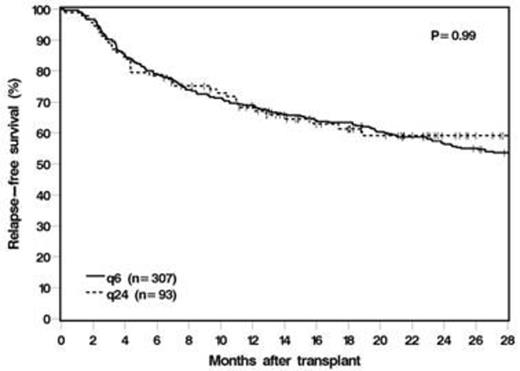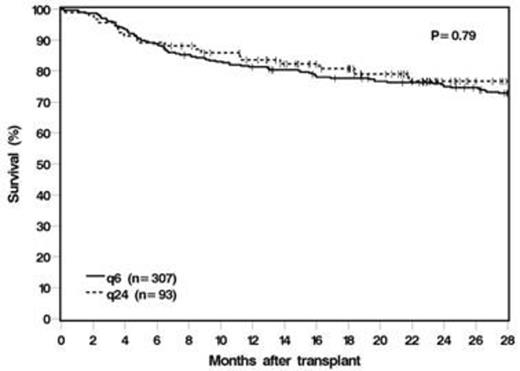Abstract
INTRODUCTION:
High dose busulfan (Bu) is an integral component of many commonly-used preparative regimens for both allogeneic and autologous transplantation. Data on the efficacy and toxicity of q6 vs. q24 hour dosing are of significant clinical interest. In order to facilitate a therapeutic dose-monitoring protocol, we transitioned from q6 to q24 Bu dosing as part of our standard Bu/Cy/VP ASCT preparative regimen for patients with Hodgkin (HL) and Non-Hodgkin Lymphoma (NHL) in July 2012. We present comparative outcomes of q24 Bu dosing vs historical controls receiving q6 Bu.
METHODS
We retrospectively reviewed 400 consecutive eligible lymphoma patients who underwent ASCT from 2007-2013 with Bu/Cy/VP. All patients received Cy 60 mg/kg IV over 4 hours on days -3 and -2 and VP 60 mg/kg as continuous infusion on days -5 and -4. Bu was given at a dose of either 0.8 mg/kg q6 (N = 307) x 14 doses for patients transplanted between 2007-July, 2012 or 2.8 mg/kg q 24 hours (N = 93) on days -9 through -6 for subsequent patients. Outcomes assessed from date of transplant were: relapse, non-relapse mortality (NRM), relapse-free survival (RFS) and overall survival (OS). Toxicity was assessed using pulmonary and liver function tests (PFTs and LFTs) at specified time-points before and after ASCT. In addition, for a subset of 22 patients receiving q24 Bu, we measured serial Bu serum levels after the first dose of Bu with an in-house liquid chromatography-tandem mass spectrometry assay using turbulent flow online extraction technology (Bunch, et al. J Chromatogr B Analyt Technol Biomed Life Sci, 2010. 878(31): p. 3255-8) and subsequently determined the cumulative Bu area-under the curve (AUC).
RESULTS
Baseline patient and disease characteristics of patients dosed with q6 and q24 Bu were similar. The median age was 55 (range 20-78) years; 63% were males. 18% had HL and 82% had NHL with a comparable distribution of subtypes in both groups. Patients in both groups had comparable rates of prior chemotherapy regimens and of complete/partial remission at the time of ASCT. Due to a change in institutional guidelines, plerixafor was more commonly incorporated in peripheral blood stem cell mobilization regimen in the q24 group compared to q6 cohort (70% vs. 39%, P <0.001). However, CD34+ doses were same in the two dosing cohorts. In terms of toxicity of the two dosing approaches, there was no significant difference in FEV1 or DLCO before and after transplant in the q6 vs q24 cohorts. LFTs measured at four time points were generally lower with q24 Bu, particularly AST and alkaline phosphatase (P=0.007 each), but these difference were not clinically significant. The median follow-up was longer in the q6 than q24 group (48.2 months vs. 21.3 months, P < 0.001). 18 month outcomes of the two dosing cohorts were comparable (see Table and Figure). We observed significant variation in AUC with weight-based dosing of Bu (AUC range 12,104 - 23,084 µM-min) with a median of 17,568 µM -min, which has served as a baseline for subsequent therapeutic-dose monitoring.
CONCLUSIONS
Q24 Bu dosing in combination with Cy/VP is more convenient than q6 hours, has equivalent outcomes, and results in no increase in either hepatic or pulmonary toxicity. Consistent with previous reports, there is a significant range of Bu AUC levels, with a standard deviation of 12%. These data provide rationale for our prospective clinical trial of real-time therapeutic dose monitoring with q24 Bu dosing.
| . | Q6 dosing . | Q24 dosing . | P-value . |
|---|---|---|---|
| OS | 78% | 80% | 0.79 |
| RFS | 63% | 61% | 0.99 |
| NRM | 5% | 3% | 0.95 |
| Relapse | 30% | 36% | 0.46 |
| . | Q6 dosing . | Q24 dosing . | P-value . |
|---|---|---|---|
| OS | 78% | 80% | 0.79 |
| RFS | 63% | 61% | 0.99 |
| NRM | 5% | 3% | 0.95 |
| Relapse | 30% | 36% | 0.46 |
18 month outcomes of q6 vs q24 Bu dosing
RFS and OS for lymphoma patients undergoing ASCT with Bu/Cy/VP treated with q6 vs. q24 hour weight-based Bu dosing.
RFS and OS for lymphoma patients undergoing ASCT with Bu/Cy/VP treated with q6 vs. q24 hour weight-based Bu dosing.
Hill:Janssen: Honoraria, Membership on an entity's Board of Directors or advisory committees; Seattle Genetics: Honoraria, Membership on an entity's Board of Directors or advisory committees; Celgene: Honoraria, Membership on an entity's Board of Directors or advisory committees; Pfizer: Consultancy, Honoraria, Membership on an entity's Board of Directors or advisory committees. Majhail:Gamida Cell Ltd.: Consultancy; Anthem Inc.: Consultancy.
Author notes
Asterisk with author names denotes non-ASH members.



This feature is available to Subscribers Only
Sign In or Create an Account Close Modal